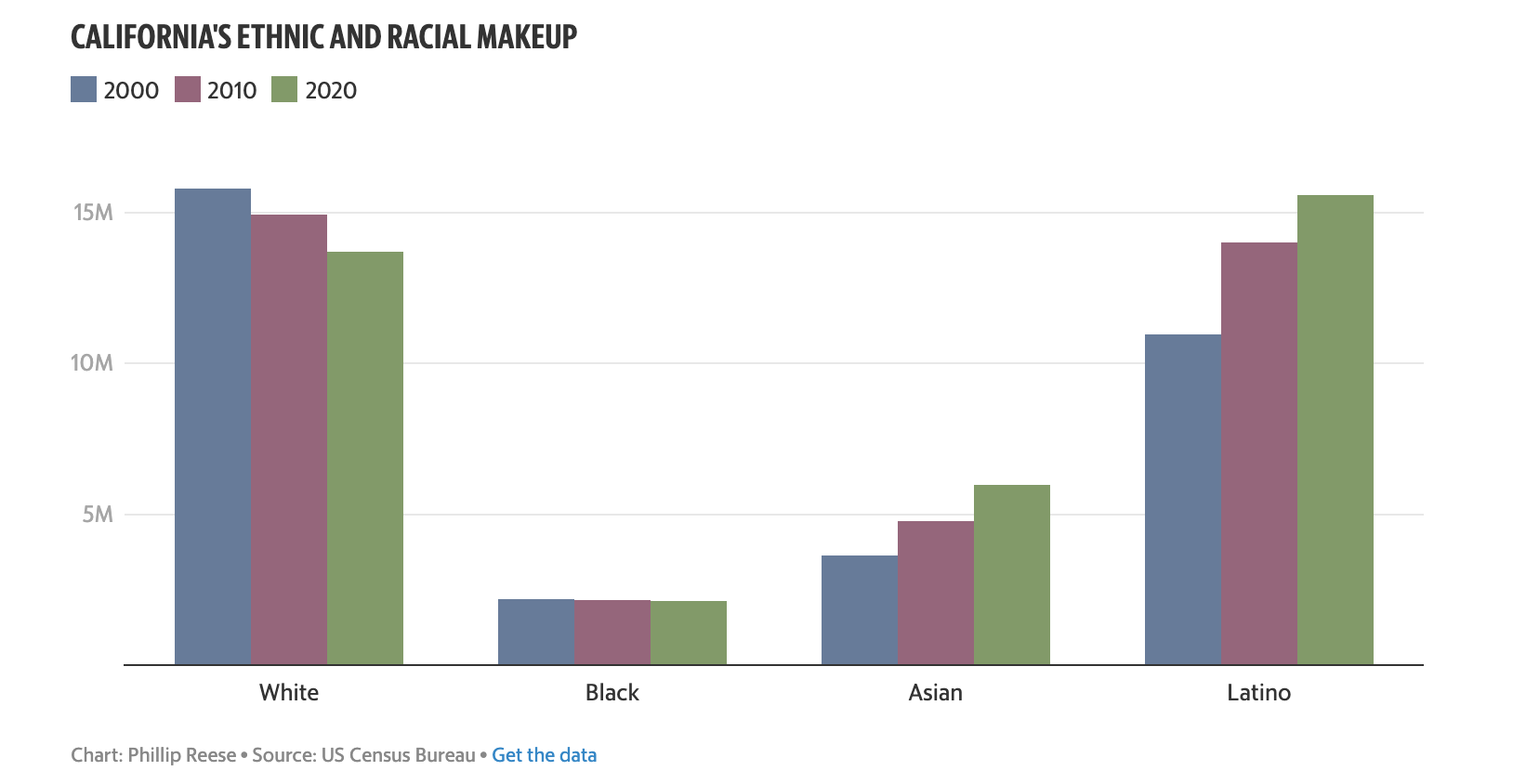BY GILLIAN BRASSIL, JEONG PARK, AND ANDREA BRISEÑO
UPDATED DECEMBER 25, 2021 10:56 AM
WASHINGTON
California’s new congressional districts give the state two more Hispanic-majority congressional districts, including seats in the Central Valley that have never sent a Latino lawmaker to Washington. Sixteen of California’s new districts are more than 50% Latino, up from 14 districts prior to redistricting, according to census data gathered in 2015. Latino voters constitute the largest ethnic group, though not the majority, in two other districts. Altogether, California’s congressional delegation will include 52 lawmakers next year. California’s population growth slowed over the last decade, leading the state to lose a seat in the U.S. House of Representatives. The little growth there was largely came from the Latino and Asian communities, census data showed, with Latinos becoming the state’s largest ethnic group.
“I think the Latino community is a winner, but that is conventional with our role in the growth in the population of California,” Thomas A. Saenz, president and general counsel at the Mexican American Legal Defense and Educational Fund, said.
The San Joaquin Valley will have have three Latino-majority districts, a proposal pushed heavily by MALDEF in drafts leading up to the maps’ finalization. But California will lose an Asian-majority district near San Jose. The commission charged with redrawing the state’s legislative boundaries had to meet a set of criteria that dictate districts’ shape and population. It also had to comply with aspects of the federal Voting Rights Act, which aims to help ethnic minority groups elect members of their choosing.
Maps will be sent to California’s secretary of state for certification before Dec. 27. They sit for public review in the meantime.
LATINO DISTRICTS BOLSTER DEMOCRATIC SUPPORT
The San Joaquin Valley’s new 13th, 21st and 22nd districts each has more than 50% Latino populations. The seats are expected to be the bases for Democratic Reps. Josh Harder of Turlock, Jim Costa of Fresno and Republican David Valadao of Hanford, respectively. Harder’s new district is just over 50% Latino, according to the redistricting commission. Costa said he would run in the Fresno-holding 21st district, which is 53% Latino. Much of that district previously housed Rep. Devin Nunes, R-Tulare. Nunes announced he would resign from the House to lead former President Donald Trump’s social media venture.
Valadao’s proposed district, considered a toss-up in 2022, is 59% Latino. His district has been majority Latino since the last time California underwent redistricting. All three districts would have heavily voted for President Joe Biden in the 2020 presidential election, suggesting that they might prefer Democrats in 2022. Saenz concurred that GOP regions in the Central Valley could become more contested following the release of the near-final draft map, presenting greater challenges for the Republican party. “I think the Republican party may lose under these maps, but that’s entirely because the Republican party in California has so thoroughly alienated the Latino voter community,” he said. Saenz and Pablo Rodriguez, the founding executive director of Communities for a New California Education Fund, which canvasses in the Central Valley, said the new maps would encourage candidates to engage more with Latinos.
He expects that the first Latino or Latina to represent the Central Valley in Congress will be elected within the next 10 years. Rodriguez said that Democratic Assemblyman Rudy Salas of Bakersfield, who is challenging Valadao, could very well be the first. “The twist here is that new districts may create the environment so running as a moderate is not seen as the only path to victory,” he said. “The future looks more like Fresno Councilmember Esmeralda Soria and Kingsburg Councilmember Jewel Hurtado than outdated white conservative Democrat Jim Costa, for example,” he said.
ASIAN AMERICANS LOSE MAJORITY DISTRICT
California lost a majority Asian-American congressional district in redistricting. The congressional district centered around Santa Clara and currently held by Rep. Ro Khanna, D-Fremont, went from a population that was almost 53% Asian, according to census data gathered in 2015, to less than 47%.
But the state has three congressional districts — Khanna’s and two others in Southern California — where Asian Americans make up the largest voting group. Advocates pushed for more representation following draft maps released a month ago that featured only one plurality congressional district. “Being at least the highest percentage of the area will give us an opportunity to feel represented and have our voice heard and hold people accountable,” said Nancy Yap, executive director of the Southern California-based nonprofit Center for Asian Americans United for Self Empowerment. Yap said the key was to keep as many districts as possible with at least 35% Asian population and was “relieved” by the final map that increased the number of such districts from three in the draft to four. Among those districts, the Asian population is very diverse. One district in Orange County has a plurality of Asian Americans, but it’s split by a heavy concentration of Korean Americans in the north and Vietnamese Americans in the south.
“I can’t pretend it won’t come with its own challenges, but there’s a shared experience of being immigrants and coming from immigrant families,” Yap said. The Black community does not constitute the largest voting-age population in any district. Black voters make up more than 34% of voters in just two districts, both of which are in and around Los Angeles. Saenz said the Black population was presented with great challenges in redistricting, given that it was neither a fast-growing population nor is it geographically concentrated. The number of Black residents in California fell by about 44,000, or 2%, to roughly 2.1 million between 2010 and now, according to the most recent census data.
“I think it’s a mistake to assert, as some people would find it convenient to do, that this is an issue of one minority community versus another,” Saenz said. “It’s not that at all.”

